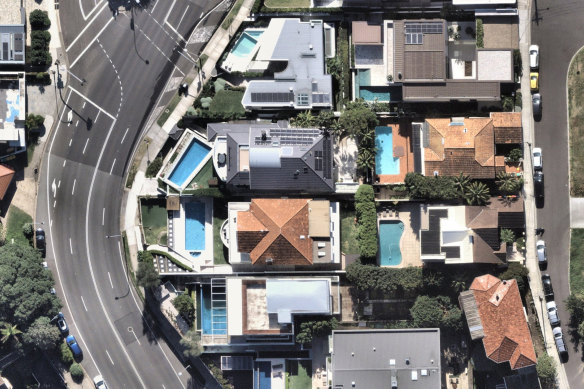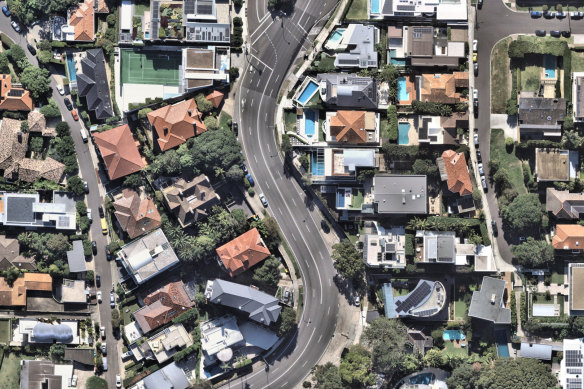Eastern suburbs council brings in tree cover quota to stop overdevelopment
McMansions will be harder to build in Sydney’s richest suburbs, with property owners forced to scale back building plans to provide room for more trees.
But the new greening rules have been criticised by property developers who say it will hinder efforts to boost housing supply, amid concern trees will be weaponised to fight new developments.
Woollahra Municipal Council will require properties to have a tree canopy of up to 35 per cent and set landscaping controls to prevent the overdevelopment of sites.

A bird’s eye view of Vaucluse reveals the lack of tree canopy on some blocks of land.Credit: Nearmap
A council spokesman said the new greening rules will boost the tree canopy on private property. Urban greening, minimising urban heat and mitigating climate change will be able to be considered during the assessment of development applications.
“One of the objectives of the new provisions is to ensure sufficient area is retained to maintain and enhance tree canopy cover,” he said.
Data from the NSW Planning Department shows one in seven Sydney suburbs has less than 10 per cent tree canopy cover and are up to 10 degrees hotter than heavily vegetated areas.
Trees more than three metres high cover about 27 per cent of public and private land in Sydney’s eastern suburbs, but Woollahra council has lost tree canopy cover over the past decade as tree planting on public land is outpaced by trees removed from private property.

Woollahra Liberal councillor Mary-Lou Jarvis said new greening rules were prompted by a spate of knockdown rebuilds in Sydney’s eastern suburbs that had resulted in the destruction of mature trees.Credit: Nearmap
Woollahra Liberal councillor Mary-Lou Jarvis said the new planning rules were prompted by a spate of knockdown rebuilds in Sydney’s eastern suburbs that destroyed mature trees.
Jarvis said established gardens and often historic trees were “being sacrificed to satisfy profit-driven motives of developers”.
The greening rules aimed to maintain leafy residential areas and “stop the concrete wall-to-wall development that has occurred in recent times”, she said.
Jarvis said the new rules also required mature trees to be planted: “Essentially throwing in a few camellia bushes and cycads will not satisfy the requirements any more”.
Fellow councillor Merrill Witt said developers used sophisticated town planning outfits to argue for non-complying development. “Approval of these types of requests sets a bad precedent and over time leads to an erosion of development standards, loss of local character and tree cover.”
Witt said she hoped the greening rules were extended to medium-density zones given that many single-dwelling houses in the eastern suburbs had been replaced by apartment buildings in the past 10 years.
“Typically, when the houses go, so does most of the garden area,” she said. “The increase in hard surfaces is putting pressure on Council’s stormwater drains and increasing the heat island effect, particularly in areas not so close to the harbour.”
Other councils such as Northern Beaches, Mosman, The Hills Shire and Ku-ring-gai require an even greater proportion of private property in some areas to be landscaped. Ku-ring-gai also requires development sites to provide a minimum number of tall trees capable of attaining a mature height of 13 metres or more.
Western Sydney University urban planning and management associate professor Sebastian Pfautsch said trees were disappearing from privately owned land at a faster rate than public land.
“I think it is not as simple as it might look to increase canopy cover, but there could be great alternatives, like regulations around green roofs and green facades,” he said.
However, Pfautsch said the council’s aim to boost its overall tree canopy to 30 per cent was meagre – especially when the NSW government has an overall target of 40 per cent tree canopy cover by 2036.
The loss of trees for road upgrades, new bike lanes and major property developments has angered residents across Sydney, while councils have also complained that laws do not deter the illegal removal of trees.
Urban Taskforce chief executive Tom Forrest said the new planning rules will prevent increased housing density in Sydney’s eastern suburbs “and a cynic might suggest that this is precisely the intent”.
Forrest said the greening rules will have a negative impact on housing supply by making it unfeasible to knock down existing buildings “no matter how tired or unfit for purpose they may be”.
He said the council should purchase land for parks and green public open space, “not impose new regulations which will hinder housing supply in an area which has produced negligible new housing stock despite strong demand”.
Committee for Sydney planning policy manager Estelle Grech said there was “great inequality” in the city’s urban tree canopy, with the leafy north enjoying 40 per cent cover while eastern Sydney has 15 per cent and western Sydney has 16 per cent.
Deep soil controls were a proven method for ensuring space for trees to grow and mature, but Grech said: “We shouldn’t be weaponising trees when it comes to development.
“They shouldn’t be used as a disguise for anti-development sentiment, just as they shouldn’t be on the chopping block in pro-development circumstances,” she said.
The Morning Edition newsletter is our guide to the day’s most important and interesting stories, analysis and insights. Sign up here.